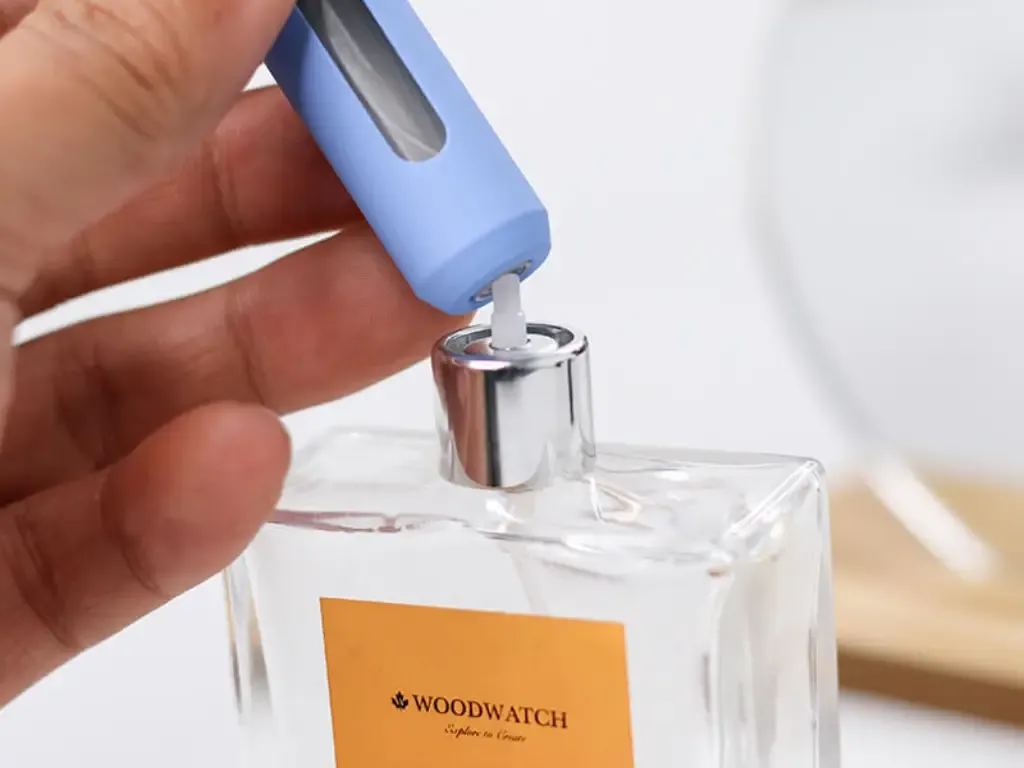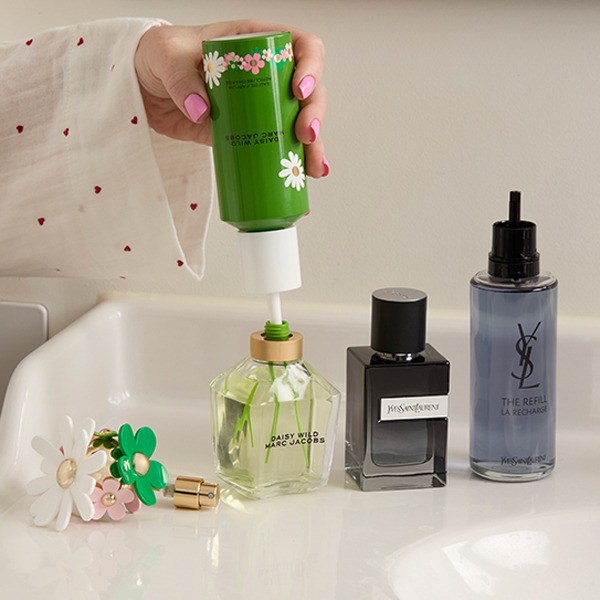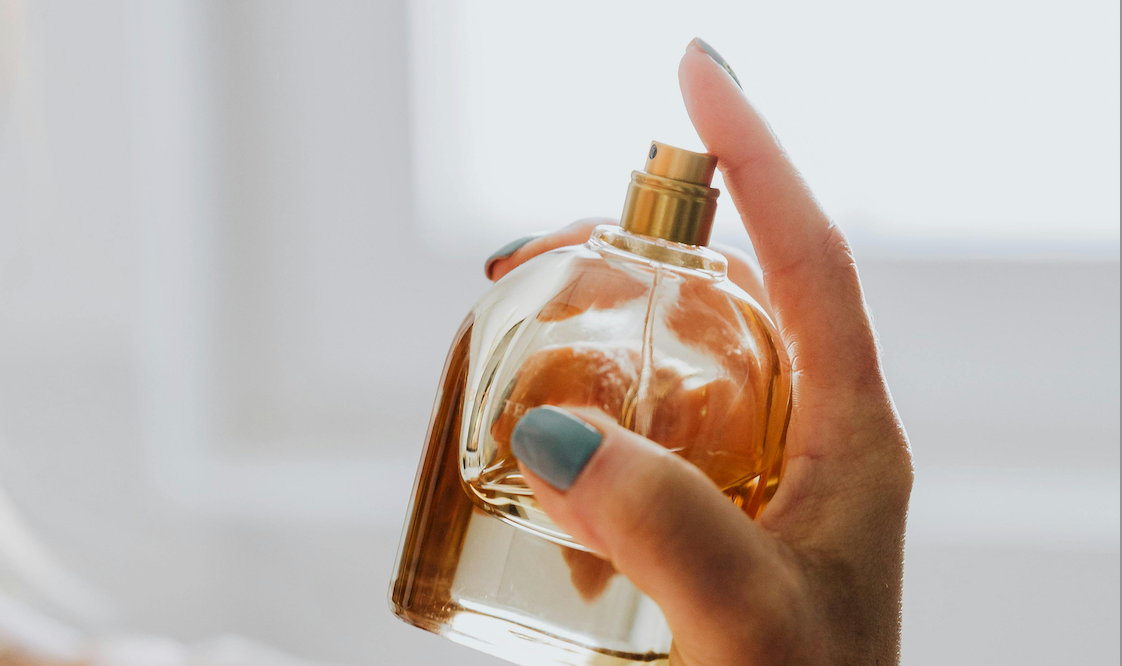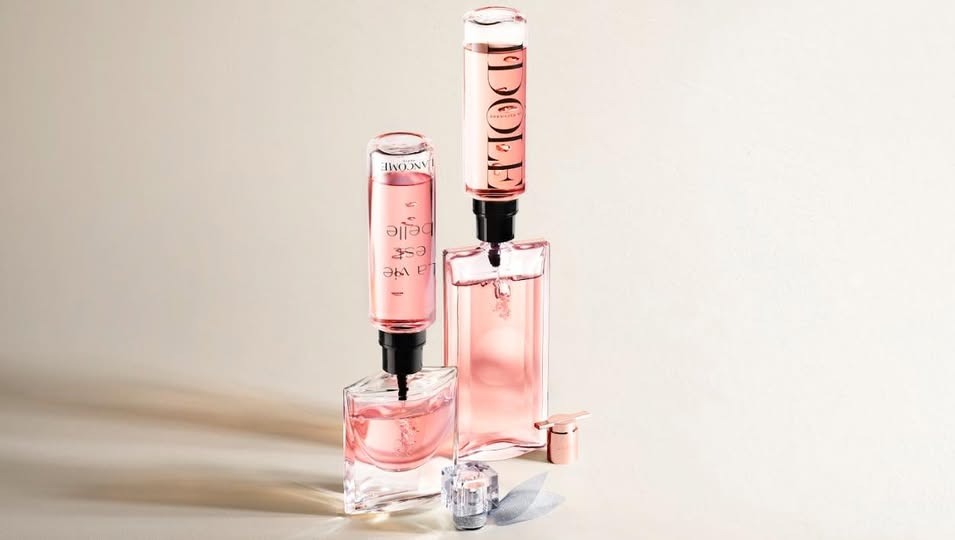Refilling your empty perfume bottle is an effective way to reduce waste and save money. Instead of discarding a beautiful vessel or constantly buying new packaging, you can extend its life by adding more fragrance. This simple, sustainable practice minimizes plastic and glass waste while letting you keep using a favorite bottle.

Table of Contents
The Clear Benefits of Refillable Perfume Bottles
Refillable perfume bottles offer a smart solution to the growing packaging waste crisis. The impact is measurable – in 2023 alone, The Perfume Shop’s recycling program kept over 8,611 bottles out of landfills, marking a 67% increase from the previous year. This shift tackles the persistent problem of disposable plastic components like nozzles, caps, and sample vials that contribute to long-lasting pollution. Choosing refills directly reduces this environmental burden.
Reducing Carbon Footprint
The environmental advantages extend beyond waste reduction. Refill systems significantly lower the carbon emissions associated with manufacturing new glass and plastic containers. Glass stands out as particularly eco-friendly since it can be endlessly recycled when processed correctly. Each refill means fewer raw materials extracted and less energy consumed in production.
Cost Savings for Consumers
There’s a compelling financial incentive too. Refills typically cost less than buying a brand-new perfume bottle since customers pay only for the fragrance itself, not the packaging. This makes luxury scents more accessible while encouraging sustainable habits – a practical win-win for fragrance lovers.
Growing Consumer Demand
Market trends confirm this movement’s momentum. Recent data shows refillable fragrances growing 23% year-over-year, significantly outpacing the 9% growth in traditional perfumes. This consumer shift is prompting brands and retailers to respond with expanded refill stations and broader refillable product ranges.
Driving Industry Innovation
This refill revolution is catalyzing broader sustainable practices across the fragrance industry. As refills become mainstream, they’re normalizing responsible consumption and paving the way for innovations like carbon-neutral production and compostable packaging. Evidence suggests these changes are fundamentally reshaping luxury perfumery toward inherently greener models.
Pioneering examples include Byredo’s elegant refillable scent systems and multi-brand refill stations appearing in beauty retailers. These initiatives make sustainable fragrance options more accessible than ever, proving that luxury and environmental responsibility can coexist beautifully.

Essential Tools for Refilling Perfume Bottles
Refilling perfume bottles requires just a few basic tools to make the process smooth and mess-free. A clean, refillable perfume bottle serves as the starting point – some caps may need gentle removal with small pliers or a precision screwdriver if they’re crimped shut.
A mini funnel is indispensable for guiding fragrance into narrow bottle openings. Stainless steel or glass funnels offer easy cleaning, though plastic versions work too. For transferring liquid, pipettes or syringes (especially for 5-10ml perfume bottles) provide excellent control and minimize waste. Specialized perfume refill pumps offer an even faster alternative for transferring between bottles.
Keeping a lint-free cloth or paper towels nearby is wise for quick cleanup of any accidental drips during the process.
Safety First: Simple Precautions
Basic safety measures make refilling worry-free. A pair of gloves protects hands from sharp glass edges and keeps bottles fingerprint-free. Safety goggles are recommended only when dealing with stubborn caps where pressure might cause splashing.
Disinfecting tools is crucial: rubbing alcohol, alcohol wipes, and a soft brush effectively clean bottles, caps, and equipment to prevent contamination. When switching fragrance types, rinsing the perfume bottle with distilled water (followed by thorough drying) prevents scent mixing or dilution.
Choosing Your Fragrance & Extras
Always opt for high-quality perfume – either the original scent or a trusted alternative. Lesser fragrances may clog spray mechanisms or damage components over time. A soft-bristled brush helps clean hard-to-reach areas like nozzle interiors or cap threads.
Scent strips come in handy for testing refilled perfumes or experimenting with blends. For portability, travel atomizers (3ml–10ml refillable perfume bottles) are perfect for purses or gym bags.
Building a Basic Refill Kit
A starter kit simplifies the process: one refillable bottle, a pipette or small syringe, a mini funnel, cleaning cloth, alcohol wipes, gloves, precision pliers, your chosen fragrance, a detail brush, and scent strips. Many retailers now sell pre-assembled kits containing these essentials. Having the right tools transforms perfume refilling into an easy, eco-friendly habit that reduces packaging waste with every reuse.

Preparing Your Empty Perfume Bottle for Refill
Thorough cleaning is essential before refilling any perfume bottle. This crucial step ensures the new fragrance remains pure and prevents contamination from old oils or bacteria.
Deep Cleaning Process
Start by filling the bottle halfway with warm water, adding a teaspoon of mild soap and a teaspoon of uncooked rice. Securely cap the bottle and shake vigorously – the rice acts as a gentle abrasive to dislodge residual perfume oils. For stubborn scents or oily residue, try soaking the perfume bottle for an hour in equal parts white vinegar and warm water before thorough rinsing.
Sterilization and Drying
After cleaning, wipe all exterior surfaces including the neck and cap with isopropyl alcohol wipes to eliminate bacteria and fingerprints. Air drying works well, though a lint-free cloth speeds up the process. Careful inspection ensures no water spots or fibers remain, as even tiny particles can compromise fragrance quality.
Pre-Refill Checks
Hold the cleaned bottle against light to spot any lingering bubbles, residue, or cloudiness. If visible, repeat rinsing – soap traces significantly alter scents. Test the spray nozzle functionality; soak clogged nozzles in warm vinegar water and clear blockages with a fine needle for optimal mist dispersion.
Helpful Tips for Best Results
• Avoid harsh chemicals that might damage glass or plastic components
• Ensure complete drying of all parts – especially atomizer mechanisms – to prevent bacterial growth or fragrance dilution
• For persistent odors, extend vinegar soaking time or add an extra rinse cycle
• Carefully remove any glass or plastic fragments near the neck using tissue to prevent injury
• Patience pays off: The 30-90 minute process (including drying time) preserves bottles for repeated use
This method works universally across bottle sizes, from compact 5ml travel sprays to generous 100ml vessels. Proper preparation maintains scent integrity and extends the life of cherished perfume bottles, making sustainable fragrance practices both practical and rewarding.
Removing the Sprayer Cap: Essential Tools & Safety Tips
Taking off the sprayer cap is often the most challenging part of refilling perfume bottles. The approach varies significantly depending on cap type, and using proper tools is crucial for both safety and preventing spills.
Identifying Cap Types
Most glass perfume bottles fall into three categories: Screw caps (common on refillable luxury brands), snap-on or crimped sprayers (frequent on designer fragrances), and mini plastic caps (typical for 5ml travel atomizers). Recognizing which type you’re dealing with determines the removal method.
Removal Techniques
For screw caps, simply grip firmly and twist counterclockwise – rubber gloves or a cloth improve traction and protect hands. Brands like Dior Sauvage typically unscrew easily within a minute.
Crimped sprayers require more care: Position needle-nose pliers at the sprayer base and gently twist upward. If stuck, carefully slide a small flathead screwdriver under the edge, rocking side-to-side to loosen the metal crimp. Avoid excessive force – rushing this process risks glass breakage or metal shards flying. Chanel No. 5 often takes 3-4 minutes using this method.
Mini atomizers need a delicate touch: Use fingernails or thin tools with a “banana peel” rocking motion to avoid cracking plastic.
Recommended Toolkit
Having these items ready simplifies the process: Rubber grip pads or gloves for protection and traction, needle-nose pliers for precision handling, small flathead screwdriver for prying, scissors for tough plastic collars, tweezers for tiny components, and a clean tray to organize disassembled parts.
Safety First
Gloves reduce hand injury risks by approximately 60%. Always work slowly – most spills and glass damage occur when rushing. Wipe the perfume bottle neck with alcohol to remove sticky residue that causes slippage. Lay out removed parts sequentially (cap, sprayer, crimp, seal) on a clean surface to prevent loss and simplify reassembly. Finally, wipe crimped heads with rubbing alcohol before refilling to maintain fragrance purity.
Choosing the right method prevents perfume loss and perfume bottle damage. Pre-organizing tools and components significantly increases success rates while protecting fragrance investments.

Positioning for a Clean Perfume Refill
Proper tool positioning is crucial for spill-free refills that preserve fragrance quality. Choosing the right equipment and technique prevents messy accidents and wasted perfume.
Selecting Your Transfer Tool
For bottles with wider necks (12–15mm+), a sanitized funnel works best – stainless steel or glass options are durable, easy to clean, and scent-neutral. Narrow-neck bottles (under 10mm) and travel atomizers require greater precision; sterile syringes or pipettes allow controlled filling with minimal leakage.
Step-by-Step Refill Process
Begin by stabilizing the perfume bottle on a non-slip surface. Sanitize tools with 70% isopropyl alcohol, waiting at least 30 seconds before use.
For funnels: Center the narrow end securely in the bottle neck. Pour steadily, stopping at 90% capacity to leave space for reassembly.
For syringes/pipettes: Position the tip just inside the opening. Fill only 70–80% of the syringe’s capacity per transfer to maintain control and prevent overflow.
Travel atomizers need special handling: Align the atomizer’s valve with your refill bottle’s nozzle before applying steady pressure – this closed-system approach reduces spill risk by over 90% compared to open pouring.
Proper tool positioning transforms refilling from a nerve-wracking task into a quick, eco-friendly habit. Taking moments to set up correctly prevents frustration, preserves precious fragrance, and supports sustainable scent enjoyment.
Mastering the Pour: Clean Refilling Techniques
The actual pouring stage determines whether refilling succeeds or becomes a costly mess. Proper technique preserves fragrance integrity, prevents waste, and maximizes bottle reuse—a simple yet impactful eco-choice.
Essential Pouring Methods
Steady control is paramount. Pour refill fragrance into the clean perfume bottle at a consistent pace, stopping just below the neck to leave 10-20% headspace. This prevents overflow when reassembling and creates a proper seal. For syringe or pipette transfers, inject perfume slowly to minimize air bubbles that accelerate oxidation.
Narrow-neck bottles benefit from specialized tools: Small funnels or refill adapters guide every drop precisely. Some enthusiasts even use lab filter paper for older fragrances to remove particulates and ensure freshness.
Brand-Specific Approaches
Travel atomizers simplify refills: Align the atomizer’s valve with your perfume bottle’s nozzle and pump 8-12 times—most 5-10ml sizes fill in under a minute without spills. Systems like Mugler’s click-on capsules are foolproof; they automatically stop filling when full.
Traditional designer bottles require manual pouring: Monitor the fill line closely, capping at 80-90% capacity. Tilting the bottle at 45° improves visibility and reduces bubble formation.
The Sustainability Payoff
This careful process yields significant environmental benefits: Refilling a single 30-100ml bottle cuts packaging waste by 50% compared to new purchases. Opting for refillable systems can reduce raw material consumption by up to 71%. When executed properly, home refilling delivers salon-quality results while actively reducing the fragrance industry’s ecological footprint.
Sealing and Cleaning Your Refilled Perfume Bottle
Proper reassembly ensures leak-proof performance and preserves fragrance integrity. A secure seal prevents evaporation while thorough cleaning maintains the bottle’s appearance.
Achieving the Perfect Seal
Align sprayer caps precisely with bottle openings before application. For snap-on or crimped tops, apply firm, steady pressure until hearing an audible click. When reattaching pry-off collars, use a thin cloth between hands and glass to prevent scratches on luxury bottles. Some designs require specialized tools: small pliers help secure stubborn crimp caps, while roll-ons need careful ball-bearing repositioning. Patience is key—rushing this step frequently causes misalignment or spills.
Post-Refill Cleaning Protocol
Wipe the bottle’s neck, sprayer, and exterior with a microfiber cloth to remove fingerprints and residue. Use a soft-bristled brush for intricate crevices. Before final assembly, disinfect all components with rubbing alcohol and allow complete air-drying—this prevents fragrance contamination from moisture or microbes.
Critical Considerations
Always maintain approximately 5% headspace below the neck. This air cushion prevents pressure buildup that causes leakage during spraying. Gloves are recommended when handling collector’s items to preserve pristine surfaces. Luxury perfume pumps often feature self-sealing mechanisms; when correctly reassembled, these maintain freshness for up to 24 months—matching unopened bottle performance.
Testing Your Refilled Perfume: Spray Quality & Leak Prevention
Thorough testing ensures refilled bottles perform like new while preventing costly leaks. This final quality check protects fragrance integrity and maximizes bottle reuse value.
Assessing Spray Performance
Begin with 2-3 test sprays into open air, directing the nozzle away from the face. This clears air pockets and reveals sprayer functionality. A properly functioning atomizer produces a fine, even mist—not streams or large droplets which indicate clogs or misalignment. For precise evaluation, hold the bottle horizontally and observe the mist pattern; professional-grade refills achieve full, even coverage matching factory standards.
Leak Detection Techniques
After spraying, immediately wipe the sprayer base and bottle neck with a clean tissue or fingertip. Any moisture signals an imperfect seal. Next, conduct the upside-down test: invert the bottle for 5-10 seconds while watching for drips near the collar. Follow with gentle shaking and another tissue pat-down. Persistent dampness requires reseating the sprayer until completely dry—careful reassembly yields leak rates below 1%.
Troubleshooting Common Issues
Uneven sprays often resolve by removing and realigning the spray head. For travel atomizers, pre-rinse with soapy water, dry thoroughly, and conduct water test sprays to eliminate residual scent memory before refilling.
Why Testing Matters
Skipping these checks risks significant fragrance degradation: Improper seals can cause 50% evaporation loss within days. For luxury or collector bottles, thorough testing is non-negotiable—it preserves scent profiles and protects investments. When executed properly, refilled bottles deliver identical performance to sealed retail products, transforming sustainable practices into premium experiences.
Smart Tips for Maximizing Refillable Perfumes
Sustainable fragrance practices extend beyond refilling bottles—thoughtful habits preserve scent quality while minimizing environmental impact. These practical approaches help fragrance enthusiasts enjoy their collections responsibly.
Optimal Storage Solutions
Store perfume bottles in cool, dark locations away from sunlight, heat sources, and humidity. Proper storage prevents over 50% of fragrance degradation caused by light exposure and temperature fluctuations. Keeping bottles in their original boxes adds extra protection against air and light. Gentle handling prevents spray mechanism damage, extending both fragrance lifespan and packaging reusability.
Labeling for Freshness Tracking
Always label refilled bottles with scent names and refill dates. Since most perfumes peak within 12-24 months after opening, this simple practice maintains quality control for multi-scent collections. Clear labeling prevents mix-ups and ensures timely usage, significantly reducing wasted fragrance.
Essential Pre-Refill Cleaning
Thoroughly clean bottles and atomizers before each refill using alcohol rinses. This crucial step removes residual oils and prevents bacterial contamination. Always ensure complete drying before adding new fragrance—small funnels or specialized atomizers during refills minimize spills and oxidation for pristine scent preservation.
Creative Bottle Reuse Ideas
Don’t discard non-refillable bottles! Upcycle them as miniature flower vases, essential oil diffusers, travel-size containers, or decorative objects. Studies show such repurposing reduces household glass waste by 20-40%. For recycling, always check local guidelines—most centers accept glass bottles bearing recycling symbols when thoroughly cleaned.
Adopting these practices transforms perfume enjoyment into an environmentally conscious ritual. Each refilled bottle represents both personal style expression and tangible progress toward sustainable luxury.
Conclusion: Embrace Sustainability with Every Scent
Refilling perfume bottles transforms luxury into a conscious ritual—slashing packaging waste, reducing carbon footprints, and unlocking long-term savings. By mastering these simple steps, anyone can extend a fragrance’s life while honoring our planet. As demand grows for refill-ready designs, TP Glass Bottle Manufacturer crafts the ideal foundation for this movement: Our laboratory-grade glass bottles feature precision necks for leak-proof refills, durable construction for 100+ reuse cycles, and customizable designs that elevate sustainable luxury. With thoughtfully engineered bottles, every refill becomes a statement—for your identity and our Earth’s future.

